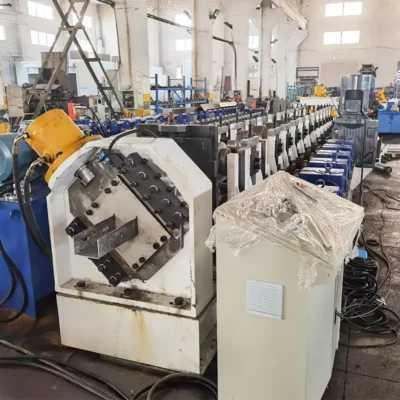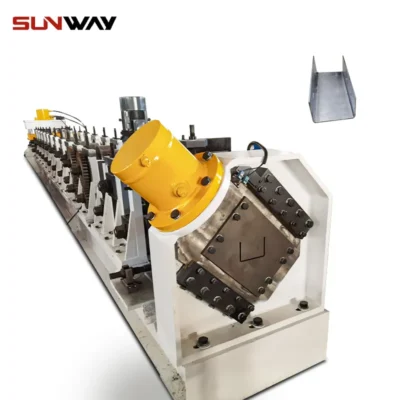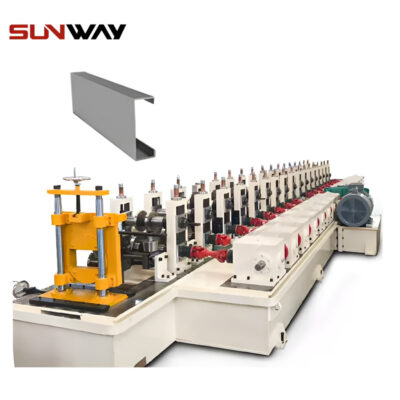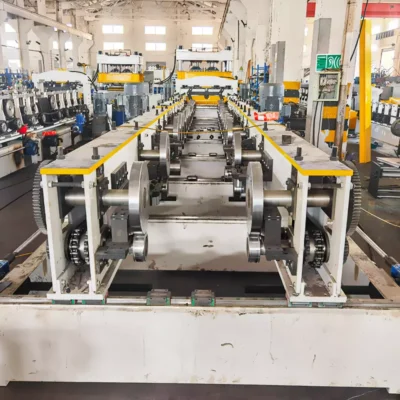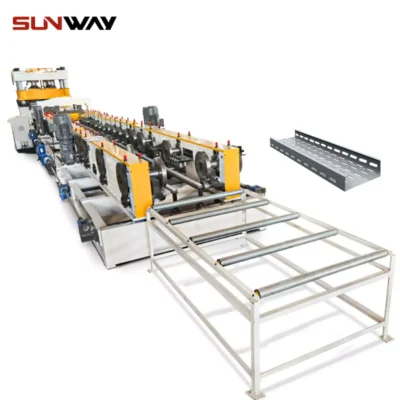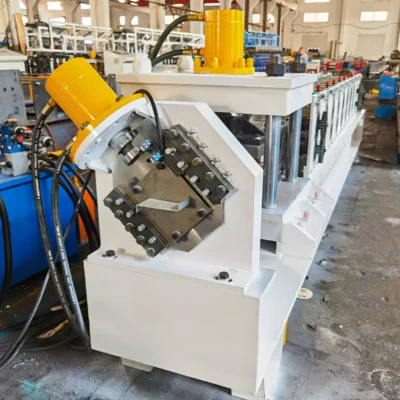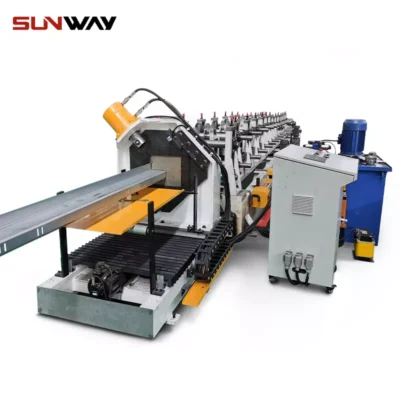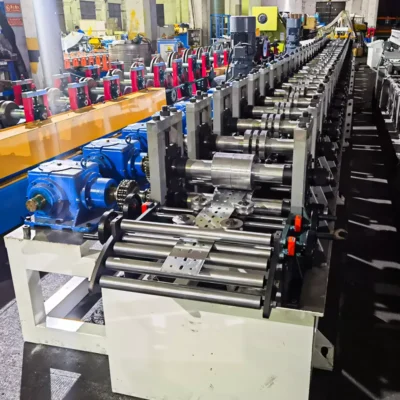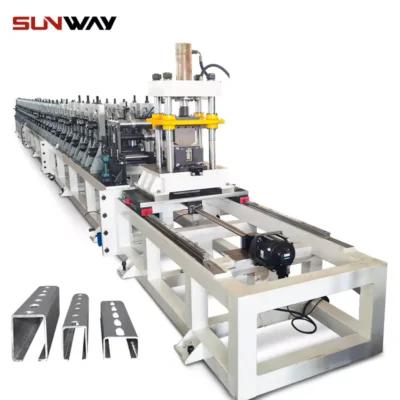The growing demand for renewable energy has placed wind turbines at the forefront of sustainable power generation. As wind turbine technology evolves, so does the need for precision, scalability, and efficiency in manufacturing components such as structural supports, tower sections, and blade reinforcements. Enter Wind Turbine Roll Forming Machines—advanced systems designed to produce high-strength and durable components essential for wind turbine construction.
In this article, we’ll explore what wind turbine roll forming machines are, their applications, pricing, automation features, environmental benefits, and why Wuxi Sunway Machinery stands out as a global leader in this field. Whether you’re a manufacturer scaling up production or a renewable energy developer exploring cost-effective solutions, this guide will provide valuable insights.
What Are Wind Turbine Roll Forming Machines?
Wind Turbine Roll Forming Machines are specialized systems that use roll-forming technology to manufacture metal components required in constructing wind turbines. These machines shape flat metal sheets or coils into precise profiles, ensuring high strength, durability, and compliance with stringent industry standards.
Given the massive scale of modern wind turbines, these roll-forming machines are designed to handle large materials while maintaining accuracy and efficiency. From producing tower sections to crafting reinforcements for blades, these machines are integral to the wind energy industry.
Key Features
- High Precision: Ensures exact dimensions, meeting the rigorous standards of wind turbine construction.
- Material Versatility: Processes high-strength steel, galvanized steel, and aluminum.
- Custom Profiles: Capable of producing unique shapes tailored to specific wind turbine designs.
- Durability: Outputs components that can withstand extreme environmental conditions.
- Scalability: Supports large-scale production to meet the growing demand for renewable energy projects.
Applications of Wind Turbine Roll Forming Machines
The components of a wind turbine must be engineered to meet stringent safety, performance, and durability standards. Roll-forming machines play a critical role in manufacturing these components with precision and efficiency.
1. Tower Sections
- Use Case: Producing cylindrical or tapered sections of wind turbine towers.
- Why It’s Essential: Provides the structural integrity required to support the turbine at high altitudes.
2. Blade Reinforcements
- Use Case: Shaping metal reinforcements for turbine blades to enhance their strength and resistance to wind forces.
- Why It’s Beneficial: Ensures the blades can withstand extreme wind speeds and prolonged operational stress.
3. Framework and Base Structures
- Use Case: Crafting the frameworks and base plates that anchor turbines to the ground or seabed.
- Why It’s Necessary: Ensures stability and safety, even in harsh environmental conditions.
4. Nacelle Components
- Use Case: Manufacturing the housing units that protect critical turbine components like generators and gearboxes.
- Why It’s Unique: Offers durability and precision, safeguarding sensitive equipment from the elements.
5. Support Beams and Braces
- Use Case: Producing braces and beams that enhance the structural integrity of the turbine.
- Why It’s Critical: Prevents structural deformations caused by continuous wind pressure and rotor movement.
6. Offshore Wind Turbine Components
- Use Case: Crafting specialized components designed for turbines installed in marine environments.
- Why It’s Relevant: Provides corrosion resistance and structural durability in high-salinity conditions.
Advantages of Using Wind Turbine Roll Forming Machines
The renewable energy sector demands manufacturing solutions that can deliver precision, efficiency, and scalability. Here’s why Wind Turbine Roll Forming Machines are indispensable for wind energy projects:
1. Precision Engineering
- Why It’s Crucial: Meets the tight tolerances required for components that must operate efficiently in extreme conditions.
2. High-Speed Production
- Why It’s Beneficial: Enables manufacturers to meet the growing global demand for wind turbines without compromising quality.
3. Customization
- Why It’s Essential: Supports the production of unique profiles tailored to specific turbine designs and site requirements.
4. Cost-Effectiveness
- Why It’s Practical: Reduces material waste and labor costs, making renewable energy projects more financially viable.
5. Durability
- Why It’s Relevant: Produces components capable of withstanding prolonged exposure to wind, rain, and temperature fluctuations.
6. Eco-Friendly Manufacturing
- Why It’s Important: Minimizes waste and supports the use of recyclable materials, aligning with the sustainability goals of wind energy.
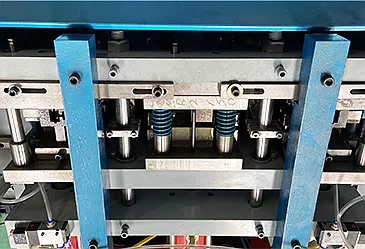
Key Features of Wuxi Sunway Wind Turbine Roll Forming Machines
Wuxi Sunway Machinery is at the forefront of roll-forming technology, offering machines specifically tailored for the wind energy sector. Here’s what sets their machines apart:
1. Advanced Material Handling
- Supported Materials:
- High-Strength Steel
- Galvanized Steel
- Aluminum
- Why It’s Beneficial: Ensures compatibility with materials that provide the strength and durability required for wind turbine components.
2. Modular Tooling Systems
- What It Offers: Interchangeable tooling for producing multiple profiles on a single machine.
- Why It’s Versatile: Supports diverse manufacturing needs without requiring additional equipment.
3. Integrated Cutting, Punching, and Welding
- What It Includes: Built-in systems for precision cutting, punching, and welding during the roll-forming process.
- Why It’s Efficient: Reduces production time and ensures ready-to-install components.
4. IoT and Automation Integration
- What It Enables: Real-time monitoring, automated adjustments, and predictive maintenance using IoT systems.
- Why It’s Revolutionary:
- Enhances production efficiency.
- Minimizes downtime and operational costs.
5. High-Capacity Production
- What It Delivers: Machines capable of producing large-scale components to meet the demands of utility-scale wind farms.
- Why It’s Essential: Keeps up with the rapid growth of the renewable energy market.
6. Eco-Friendly Design
- What It Includes: Energy-efficient motors, optimized workflows, and waste reduction systems.
- Why It’s Sustainable: Supports global efforts to reduce the carbon footprint of manufacturing.
Pricing of Wind Turbine Roll Forming Machines
The cost of a Wind Turbine Roll Forming Machine depends on its features, production capacity, and customization options. Below is a general pricing guide for 2025:
| Machine Type | Capabilities | Price Range (USD) |
|---|---|---|
| Standard Machines | Basic profiles for towers and supports | 500,000–500,000–500,000–1,200,000 |
| Advanced Machines | High-speed, integrated cutting and welding systems | 1,200,000–1,200,000–1,200,000–2,500,000 |
| Fully Customizable Machines | IoT-enabled, modular tooling, eco-friendly features | 2,500,000–2,500,000–2,500,000–5,000,000 |
For detailed pricing and financing options, contact Wuxi Sunway Machinery.
Automation in Wind Turbine Roll Forming Machines
Automation is transforming the manufacturing landscape, and Wind Turbine Roll Forming Machines are no exception. Here’s a look at some advanced automation features:
1. Real-Time Defect Detection
- What It Includes: AI-powered systems that identify surface defects, misalignments, or structural faults in real time.
- Why It’s Valuable: Ensures only flawless components are used, reducing waste and rework.
2. Predictive Maintenance
- What It Tracks: IoT sensors monitor wear and tear on components and predict maintenance needs before failures occur.
- Why It’s Revolutionary: Prevents unexpected downtime and extends the lifespan of the machine.
3. Adaptive Roller Adjustment
- What It Does: Automatically adjusts roller positions based on material thickness and profile designs.
- Why It’s Beneficial: Eliminates manual calibration, improving efficiency and precision.
4. Cloud-Based Monitoring and Control
- What It Includes: Remote access to operational data, diagnostics, and controls via cloud-based systems.
- Why It’s Convenient: Allows operators to oversee production from anywhere, ensuring maximum uptime.
5. Multi-Profile Production
- What It Enables: Seamlessly switches between various profiles within a single production run.
- Why It’s Convenient: Supports diverse manufacturing needs without additional setup time.
Environmental Benefits of Wind Turbine Roll Forming Machines
As the world shifts toward renewable energy, the manufacturing processes behind these technologies must also align with environmental goals. Here’s how Wind Turbine Roll Forming Machines contribute to sustainability:
1. Reduced Material Waste
- How It’s Achieved: Precision engineering minimizes scrap material during production.
- Impact: Conserves resources and reduces disposal costs.
2. Energy Efficiency
- How It Works: Machines are equipped with energy-efficient motors and optimized workflows.
- Impact: Reduces energy consumption and the carbon footprint of manufacturing.
3. Use of Recyclable Materials
- What It Supports: Processes materials like aluminum and steel, which are fully recyclable.
- Impact: Encourages sustainable practices and promotes a circular economy.
4. Long-Lasting Outputs
- Why It Matters: Produces durable components that reduce the need for frequent replacements.
- Impact: Supports the longevity and reliability of wind turbines.
FAQs About Wind Turbine Roll Forming Machines
| Question | Answer |
|---|---|
| What materials can these machines process? | High-strength steel, galvanized steel, and aluminum. |
| What is the production speed? | Up to 100 meters per minute, depending on material and profile complexity. |
| Are these machines eco-friendly? | Yes, they include energy-efficient motors and minimize material waste. |
| Can these machines handle custom designs? | Absolutely! Modular tooling supports bespoke profiles for diverse wind turbine components. |
| What is the price range for these machines? | Prices range from 500,000to500,000 to 500,000to5,000,000, based on features and customization. |
| Do these machines integrate with IoT systems? | Yes, IoT-enabled features allow real-time monitoring and predictive maintenance. |
Real-World Success Stories: Wind Turbine Roll Forming Machines in Action
The efficiency and reliability of Wind Turbine Roll Forming Machines have enabled manufacturers worldwide to meet the increasing demand for wind energy infrastructure. Below are some key success stories that demonstrate how these machines have transformed the production landscape.
1. Offshore Wind Farm in Europe
Client: A prominent renewable energy developer specializing in offshore wind farms.
Challenge: The client needed corrosion-resistant tower sections and base structures for turbines stationed in high-salinity marine environments.
Solution: Wuxi Sunway supplied a roll-forming machine capable of processing galvanized steel with anti-corrosion coatings applied during production.
Outcome:
- Produced tower sections with superior corrosion resistance, extending the turbines’ operational lifespan by 20 years.
- Increased production capacity by 35%, enabling the wind farm to be operational ahead of schedule.
- Reduced material waste by 15%, cutting overall project costs.
2. Onshore Wind Turbine Project in North America
Client: A manufacturer supplying components for onshore wind turbine installations in remote areas.
Challenge: The client required lightweight yet durable support braces that could be easily transported and assembled on-site.
Solution: Wuxi Sunway provided a roll-forming machine optimized for high-strength steel with integrated cutting and welding features.
Outcome:
- Delivered components that reduced overall turbine weight, improving transportation efficiency.
- Enhanced the structural stability of turbines, ensuring safety in high-wind conditions.
- Achieved a 25% reduction in production time, meeting tight project deadlines.
3. Hybrid Wind-Solar Energy Project in Asia
Client: A renewable energy contractor developing a hybrid wind-solar power plant.
Challenge: The project required custom-designed turbine components compatible with hybrid energy systems.
Solution: Wuxi Sunway supplied a roll-forming machine with modular tooling for producing bespoke profiles tailored to the hybrid system’s specifications.
Outcome:
- Enabled the creation of innovative, multi-functional components.
- Strengthened the contractor’s position as a leader in hybrid energy solutions.
- Achieved a 20% cost reduction compared to traditional manufacturing methods.
4. Small-Scale Wind Turbines for Rural Electrification in Africa
Client: A non-profit organization focused on providing renewable energy to rural communities.
Challenge: The organization needed cost-effective and scalable solutions for manufacturing small-scale wind turbine components.
Solution: Wuxi Sunway delivered a compact roll-forming machine designed for lightweight materials such as aluminum.
Outcome:
- Produced affordable components suitable for small-scale applications.
- Empowered rural communities with access to sustainable energy.
- Reduced the carbon footprint of the manufacturing process, aligning with the non-profit’s mission.
Troubleshooting Common Issues in Wind Turbine Roll Forming Machines
Even the most advanced Wind Turbine Roll Forming Machines may encounter operational challenges. Here’s a guide to troubleshooting common issues and maintaining seamless production.
1. Inconsistent Component Profiles
- Symptoms: Produced components vary in dimensions or fail to meet design specifications.
- Possible Causes:
- Misaligned rollers or worn-out tooling.
- Uneven material feeding.
- Solution:
- Regularly inspect and recalibrate rollers to ensure proper alignment.
- Use high-quality, uniform raw materials to prevent inconsistencies.
2. Material Jams During Feeding
- Symptoms: Material stops or becomes stuck during the feeding process.
- Possible Causes:
- Incorrect feeder tension or alignment.
- Debris or foreign objects in the feed path.
- Solution:
- Adjust feeder settings to match material specifications.
- Clean the feed path and inspect for obstructions before starting production.
3. Rapid Tool Wear
- Symptoms: Cutting and welding tools require frequent replacements, leading to downtime.
- Possible Causes:
- Low-grade materials causing excessive wear.
- Insufficient lubrication of moving parts.
- Solution:
- Opt for high-grade materials designed for roll forming.
- Implement a maintenance schedule to lubricate and clean tools regularly.
4. Machine Overheating
- Symptoms: The machine operates inefficiently or shuts down unexpectedly.
- Possible Causes:
- Overloaded motors or prolonged operation at maximum capacity.
- Blocked cooling vents or insufficient airflow.
- Solution:
- Operate the machine within its recommended capacity.
- Ensure proper ventilation and clean cooling systems regularly.
5. Software or Control Panel Failures
- Symptoms: The machine’s control system becomes unresponsive or fails to execute commands.
- Possible Causes:
- Outdated software or firmware.
- Faulty electrical connections.
- Solution:
- Update the machine’s software to the latest version.
- Inspect and repair electrical connections to ensure proper functionality.
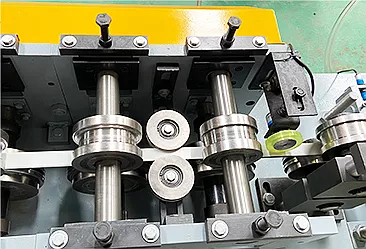
Global Market Trends for Wind Turbine Roll Forming Machines in 2025
The demand for wind energy is surging globally, driven by advancements in technology, government incentives, and sustainability goals. Here are some key trends shaping the market for Wind Turbine Roll Forming Machines:
1. Expansion of Offshore Wind Farms
- Trend: Countries are investing heavily in offshore wind projects to harness stronger and more consistent wind resources.
- Impact: Machines capable of producing corrosion-resistant and large-scale components are in high demand.
2. Growth in Emerging Markets
- Trend: Developing countries in Africa, Asia, and South America are adopting wind energy to meet growing electricity demands.
- Impact: Cost-effective and scalable roll-forming solutions are essential for these markets.
3. Focus on Hybrid Energy Systems
- Trend: The integration of wind energy with solar and battery storage is gaining traction.
- Impact: Machines that can produce multi-functional components are becoming increasingly valuable.
4. Advancements in Blade Design
- Trend: New blade designs aim to improve efficiency and reduce noise.
- Impact: Roll-forming machines with advanced tooling for blade reinforcements are crucial.
5. Commitment to Sustainability
- Trend: Manufacturers are adopting eco-friendly practices to align with global sustainability goals.
- Impact: Machines designed to minimize waste and use recyclable materials are setting industry benchmarks.
Advanced Automation Features in Wind Turbine Roll Forming Machines
Automation is revolutionizing the manufacturing process, enabling greater efficiency and precision in producing wind turbine components. Here are some of the most advanced automation features available in Wind Turbine Roll Forming Machines:
1. AI-Powered Defect Detection
- What It Includes: Artificial intelligence systems that identify defects in real time.
- Why It’s Valuable: Reduces waste and ensures only high-quality components proceed to assembly.
2. Predictive Maintenance
- What It Tracks: IoT sensors monitor machine components and predict maintenance needs before issues arise.
- Why It’s Revolutionary: Minimizes downtime and extends the machine’s operational lifespan.
3. Adaptive Roller Adjustment
- What It Does: Automatically adjusts roller positions based on material thickness and profile requirements.
- Why It’s Beneficial: Improves precision and reduces setup time.
4. Multi-Profile Production
- What It Enables: Seamlessly switches between different component profiles within a single production run.
- Why It’s Convenient: Supports diverse manufacturing needs without additional tooling changes.
5. Remote Monitoring and Control
- What It Includes: Cloud-based systems for monitoring and controlling the machine from any location.
- Why It’s Useful: Allows operators to oversee production and troubleshoot issues remotely, ensuring maximum uptime.
Why Choose Wuxi Sunway Machinery for Wind Turbine Roll Forming Machines?
Wuxi Sunway Machinery has established itself as a global leader in roll-forming technology, offering cutting-edge solutions for the renewable energy sector. Here’s why manufacturers consistently turn to Wuxi Sunway:
- Proven Expertise: Decades of experience in designing high-performance roll-forming machines for energy applications.
- Global Reach: Trusted by clients across Asia, Europe, the Americas, and beyond.
- Innovation-Driven: Incorporates IoT, AI, and modular tooling into their machines to enhance efficiency.
- Sustainability Commitment: Designs machines that align with the renewable energy industry’s focus on reducing environmental impact.
- Comprehensive Support: Provides exceptional consultation, installation, training, and after-sales service.
Explore their range of roll-forming solutions on the official website.
FAQs About Wind Turbine Roll Forming Machines
| Question | Answer |
|---|---|
| What materials can these machines process? | High-strength steel, galvanized steel, and aluminum. |
| What is the production speed? | Up to 100 meters per minute, depending on material and profile complexity. |
| Are these machines eco-friendly? | Yes, they include energy-efficient motors and minimize material waste. |
| Can these machines handle custom designs? | Absolutely! Modular tooling supports bespoke profiles for diverse wind turbine components. |
| What is the price range for these machines? | Prices range from 500,000to500,000 to 500,000to5,000,000, based on features and customization. |
| Do these machines integrate with IoT systems? | Yes, IoT-enabled features allow real-time monitoring and predictive maintenance. |
Conclusion: A New Era of Renewable Energy Manufacturing
Wind Turbine Roll Forming Machines are revolutionizing the renewable energy sector by enabling the efficient production of critical wind turbine components. With their precision, scalability, and eco-friendly design, these machines are paving the way for a sustainable energy future.
Ready to power up your manufacturing capabilities? Partner with Wuxi Sunway Machinery and explore their state-of-the-art roll-forming solutions for the wind energy industry. Together, let’s harness the power of the wind to build a greener, brighter future.

